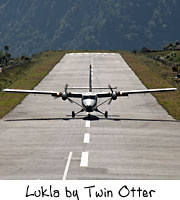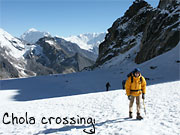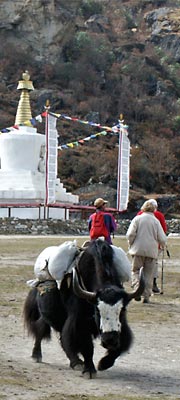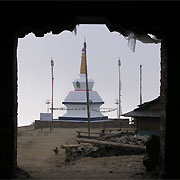| Our treks | Expeditions | Contact us | About us | Photos |





|
The reality of trekking"On the map each day's march looked pitifully short. But in such country there is no monotony. Up to the ridge ahead or down to the next river there is always something to go for and something fresh to see. Let the saddle-sore cyclist caper joyfully across the flat, but for the man on foot, the more broken the country the better. He sees not whither he must go nor whence he has come; neither far enough ahead, nor behind, to modify his cheerful estimate of the distance run or to be done. [But] however reasonable and true such ideas are to a man seated in a chair, they take on a different hue when the same man is 'bummelling' along the tracks of Nepal. Witness the notes made of one march: 'up a steep narrow track, like walking in a sewer, 500 stone steps up to Samri - no view - 2000 ft. down - hellish steep and rough track - porters slow - no view - no bananas - no raksi." - HW Tilman from "Nepal Himalaya", available in Kathmandu, and is a great Nepal read. The joy of trekkingFor the first time trekker the prospect of trekking in the Himalaya can be daunting as well as thrilling. Compared to a week's backpacking in the Rockies or bush walking in Tasmania, trekking in Nepal is an altogether different experience. Rather than jumping into the wilderness to get away from it all, you walk into a countryside free from roads. Villages caught in a time warp abound, their terraced fields stacked up huge hillsides. The paths are timeless pilgrimage routes, trails between villages or tracks to high grazing pastures. It is by no means wilderness, but it is an incredibly beautiful natural world. Only higher up in the alpine valleys are the villages left behind, to be replaced by herder's huts and higher still, the ice castles of the lofty Himalaya. The practical aspects of trekking are surprisingly easy. In the villages and along the way are lodges and teahouses where meals are ordered from menus in English. Alternatively, on a trekking tour 3 course meals are served by your crew. Without the need to carry food and camping equipment backpacks are light and, if using a porter, you end up only with a daypack. So trekking is really little more than a pleasurable ramble through quaint villages, gazing in wonder at the terraced hillsides and wandering amid incredible mountain scenery. The satisfaction of trekking is in the process. Following this most standard trekking days are not particularly long. There is time enough for spotting wildlife, photography, chatting along the way and relaxing over lunch or a reviving cup of tea. But there are challenges; for the unwarned the first is the physical effort required. Accompanying the inspiring mountains are huge hills, some of which must be climbed. Although hopefully lightly laden, hill-climbing still means plenty of heavy breathing and sweat. Pleasure can be had from frequent rests; admiring the scenery which, even after a mere 10 minutes uphill battle, alters satisfyingly and often dramatically. Take comfort too in the frequent teahouses which are often strategically placed. The second discomfort is sickness. This is Asia and no matter how careful you are, count on some usually minor bowel problems or even a day you wish to forget. Luckily, these seem trivial compared to the whole wonderful experience. To enjoy the Himalaya you don't have to be the tough outdoorsy type. Like rucksacks and cameras, trekkers come in all shapes and sizes, and with widely differing aspirations. Trekking is physical but certainly not beyond the majority of people. Most important is knowing that you enjoy the concept. Bring along a traveller's curiosity and a sense of humour, and before you know it you will relish the thought of another trek. IntroductionThe facilities in the hills may be better than in Tilman's time, but the trails are the same, and mostly we run very real treks. The following are adapted from trip diaries and emails, special thanks to Bob Rosenbaum who trekked the Kangchenjunga Magic 2000 and Stephen Kania who trekked the Christmas High Khumbu 2001. Although it is written for Nepal it applies equally for our India treks. These excerpts are about the Kangchenjunga Magic trek: "I had no idea it would be so difficult. If I'd known, I'd never have come. I'm really glad I didn't know, 'cause I'm really glad I came." Wes, Kanchenjunga (60ish) "Maybe I was overconfident or did not read everything... , but I thought trekking peaks were easier. Don't get me wrong, I loved the climb and felt very secure with you as guide. But trekking peaks are not afternoon walks." Carsten N
Joel points out a landslide on the hill, across a defile, and says we'll be crossing it tomorrow morning. Since this involves dropping down a considerable ways, then contouring around a mountain (or "hill," as Dawa would call it), then going back up a considerable ways, I can't believe it. The map shows us going down to the river and following the river upstream; why don't we just drop down to the river and follow it? I will learn that: a) Nepalese maps aren't accurate b) you always go severely up, then down, then up, then around, then down, then up on trails in this area. .. The kitchen crew clears and cleans for us - talk about luxury! - and it's time to pack up our daypacks and set off. Today we'll be losing around 3000 feet; on the map it looks like such a trivial, gradual descent that I anticipate it won't be enough of a hike. I still can't believe Joel is right, and that we'll be going up that mountain across the way. I am prepared, once we arrive at our camp, to argue we should go further, perhaps even an extra stage. Hah. What I quickly discover is that the previous day was not an anomaly. After a very short traverse past farmhouses, we indeed head down through dense vegetation, and are soon hot and sweaty. After a bit we come to our first Nepalese bridge: wooden planks suspended from cables, with an occasional plank or two missing. Very picturesque as it bends and snakes from one side of the mini-gorge to the other; very surprising to find as you cross that it sways: not only side to side, but also up and down in a sinusoidal motion. Furthermore, if someone else steps on the bridge while you're crossing, their rhythm creates motion waves which interfere with yours, and you get interference effects. Keeping your footing takes a bit of a knack; once you have the knack, it's rather fun (and I'll soon be aping Dawa by running and stomping across the bridges and laughing). Initially, though, it's a bit disconcerting. It's dark at the bottom of the mini-gorges, with bright blue sky and green hills above us. Pretty soon we start going steeply up - and up - and up. Yes, uphill on that mountain and across the bare avalanche chute (which is stable). Then around the hill, down and down, up and up. The trail is rough, with stones and slippery mud designed to twist ankles, and steep "steps" which climb and descend at ladder-like angles which have the virtue of being brutally direct and making you appreciate Sierra switchbacks. The rough "steps" are not deep enough for Western feet, and make going down in some ways more difficult than climbing up; we have to pick our way carefully to avoid slipping and falling. Bob Rosenbaum
You are definitely asking the right questions with regard to preparation. We met all kinds on the trail and ultimately, it seems possible for almost anyone to do the trek so long as they have a reasonable level of fitness. However, I also don't want you to think that it is trivial to do without being prepared. I'm a physician and definitely a "weekend warrior" at best when it comes to physical activity. I'm "40-ish", and my 2 travelling companions were varying degrees of "50-ish". I felt reasonably well prepared with what my companions and I did as lead up, although there is no doubt in my mind that the fitter you are the better - and we could/should have strived to have been a whole lot fitter. Anyway we started planning for the trip over a year before we went. Our intention was to get out on a trail for at least a day hike every weekend. With that goal, the reality was that we probably managed an average of about 4 hours on a trail every other weekend. A couple times we managed to take a whole day and get up Mt. San Antonio (an elevation gain of about 6000ft to a summit at about 10,000 ft). In the last 3 months before the trip we also worked in 3 successful and 1 unsuccessful attempts at climbing some of the California "Fourteeners" - including a successful assault on Mt Whitney. I think that helped a lot (at least with confidence that we might be able to handle the altitude in the Everest region - although, of course, there is nothing in the lower 48 states to really compare). I wish we had done a lot more, but practically speaking that was really it. I'd also recommend something like that as pretty much the minimum. In addition, I'd be pretty adamant that working out in the gym is no replacement for getting on a trail (preferably one with at least a bit of altitude gain), with a pack on your back - not to mention the trail being more enjoyable... Getting on the trail as prep is also a great way to figure out what equipment works for you and what doesn't. Even better if you can get to somewhere cold to test out cold weather gear - because for sure you are going to be cold at some point in Nepal... Stephen K, High Khumbu trek
 all rights reserved --
frozen in time July 2013
all rights reserved --
frozen in time July 2013
|

|